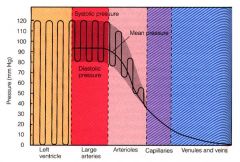![]()
![]()
![]()
Use LEFT and RIGHT arrow keys to navigate between flashcards;
Use UP and DOWN arrow keys to flip the card;
H to show hint;
A reads text to speech;
32 Cards in this Set
- Front
- Back
|
What effect does Atropine have on Heart rate?
|
Increased HR
|
|
|
What effect does increasing aortic Blood pressure have on stroke volume?
|
SV is reduced
|
|
|
Stroke work = ____x____
|
Stroke work = SV x Arterial BP
|
|
|
what effect does lowering aortic BP have on Stroke volume?
|
SV is increased
|
|
|
What is positive ionotropic effect (ionotropism)?
|
increases contractility of heart
|
|
|
afterload is ____ blood pressure
|
aortic
|
|
|
a positive ionotropic effect would shift ventricle to _____ on SV/LVEDV graph.
|
left, increase contractility
|
|
|
What effect does a catecholamine have on heart and give examples of some catecholamines.
|
positive ionotropic effect, increases heart contractility. Examples are Norepinephrine and epinephrine, and isoproterenal(best for Beta-1)
|
|
|
what is aferload
|
aortic blood pressure
|
|
|
What are units of blood FLOW?
|
(vol/time) L/min
|
|
|
Velocity=_____/______
|
distance(cm)/Unit time(min)
|
|
|
Force exerted by blood on the walls of the vessel is
|
Pressure
|
|
|
What are units of pressure?
|
(force/area) dynes/cm^2
|
|
|
slows blood flow, blood tends to flow in layers and can impediment each other as they slide over blood vessels, this is known as...
|
Resistance (frictional resistance)
|
|
|
What part of the heart would you find a systolic/diastolic of 130/80mmHG?
|

there
|
|
|
Diastolic BP + 1/3pulse pressure is....
|
Mean Blood pressure
|
|
|
what is pulse pressure
|
difference between highest BP and lowest BP(120-80)
|
|
|
HARD:
1. What is the equation for FLOW? 2. What is equation for change in pressure? 3.what is equation for R or ΔP/Q? 4. The pressure gradient (dynes/cm^2) is...? |
Determinants of vascular resistance Poiseuille’s law
1. Q= ΔP / R 2. ΔP = P1 ‑ P2 3. ΔP/Q=(8×L×η) / (π×r4) 4. ΔP = Pressure gradient(dynes/cm^2) -xtra: Q = flow (ml/sec; cm3/sec) |
|
|
_____ is gradient of Pressure from one end of vessel to the other(difference)
|
Flow
|
|
|
In the equation for Resistance (ΔP/Q=(8×L×η) / (π×r4)) doubling the _(1) and _(2) doubles the Resistance.
|
(1) length
(2) viscosity (η) |
|
|
An (increase/decrease) in RBCs would make the blood more viscous.
|
Increase
|
|
|
Lowered resistance and hematocrit is charecteristics of what blood disorder?
|
anemia
|
|
|
Increasing the radius (increases/decreases) resistance
|
decreases
|
|
|
What affect would vasodilation have on Radius, resistance, change in pressure, and flow(vol/time)
|
-increase radius
-decrease Resistance -Change in pressure remains the same -Flow increases |
|
|
What affect would vasoconstriction have on Radius, resistance, change in pressure, and flow(vol/time)
|
-decrease radius
-increase resistance - decrease flow -change in pressure remains the same |
|
|
is velocity of a vessel greater at sides or middle?
|
middle
|
|
|
doubling change in pressure would ___ flow
|
double flow
|
|
|
What is poiseiulle's law?
|
Flow(Q with dot above)=Change in pressure/Resistance
|
|
|
HARD:
What is reynolds number? |
(density x velocity x vessel diameter)/viscosity
|
|
|
______ is the total flow of systemic circulation
|
Cardiac output
|
|
|
Hard:
CO= (_____-_____)/_____ |
CO=Mean arterial BP(MABP)-Rt atrial pressure/Total peripheral resistance(TPR)
|
|
|
This area has a pressure of 1-2mmHg.
|
rt atria or venous pressure
|

